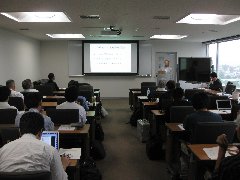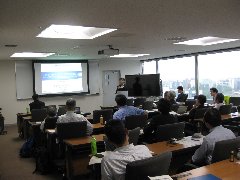[an error occurred while processing this directive]
The sixth scientific workshop
presented by the 23rd URSI-C in Japan
Session title: "Fundamentals and Applications of Decoupling Circuits for Multiple Antennas"
1. Convener: Dr. Toru Fukasawa, Mitsubishi Electric Corporation.
2. Date/time: 13:20 - 16:20, June 16th, 2016
3. Venue: Hokkaido University (Kita-ku, Sapporo)
4. Registration fee: Free
5. Listed attendees: 26 persons
6. Local arrangement: Dr. Takashi Hikage (Hokkaido University)
7. Session title: "Fundamentals and Applications of Decoupling Circuits for Multiple Antennas"
8. Presentation:
- 13:20 - 13:30 Opening Remarks, Prof. Dr. Nobuyoshi Kikuma, Chair, Commission C of URSI-JNC (Nagoya Institute of Technology)
- 13:30 - 14:10 "Decoupling Analysis and Circuits Design for Multi Beam Antennas", Honorary Prof. Dr. Kenichi Kagoshima (Ibaraki University)
- 14:10 - 14:50 "Broadband Design for Decoupling Circuits", Dr. Hidetoshi Makimura (Mitsubishi Electric Corporation)
- 14:50 - 15:00 Coffee Break (10 min.)
- 15:00 - 15:40 "Investigation for Decoupling Characteristics for MIMO Antennas using Mutual Admittance", Hiroshi Sato (Panasonic Corporation)
- 15:40 - 16:20 "Characteristics of Spatial Decoupling of MIMO Antennas for Full-Duplex", Associate Prof. Dr. Naoki Honma (Iwate University)
- 16:20 Closing
9.Reception: Attendees 16 persons at Kirin Beer Garden, Urban New build.
10.The Steering committee meeting took place from 12:00 to 13:00 on June 16th, 2016.
11. Concluding Remarks
The 6th workshop of 23rd URSI-C was held in Sapporo, a northern city in Japan. The theme was 'Fundamentals and Applications of Decoupling Circuits for Multiple Antennas.' Lately, multiple antennas system has been commonly used for small radios. When multiple antennas are set inside a small radio, coupling between antennas causes some problems, such as degradations of efficiency and of correlation coefficient. The decoupling circuits are one of the effective methods to overcome such problems. They have been widely studied for about 10 years. The decoupling circuits do not only reduce coupling between antennas, but also have many interesting features, such as orthogonality between each radiation patterns for each eigenmodes, relation between Q-factor and each eigenmodes, and so on. The decoupling circuits have both spatial and circuit nature. Further, the technology has been utilized actual products of small radios. They are interesting as a target of investigation and practical use.
In the workshop, Honorary Professor Kagoshima from Ibaraki University, Dr. Makimura from Mitsubishi Electric Corporation, Dr. Sato from Panasonic Corporation, and Associate Professor Honma from Iwate University have presented 'Decoupling Analysis and Circuits Design for Multi Beam Antennas', 'Broadband Design for Decoupling Circuits', 'Investigation for Decoupling Characteristics for MIMO Antennas using Mutual Admittance', 'Characteristics of Spatial Decoupling of MIMO Antennas for Full-Duplex', respectively. Prof. Kagoshima explained vector analysis to reduce coupling between dipole antennas, showing orthogonal characteristics of radiation patterns for each eigenmodes, and relation between Q-factor and each eigenmodes. Dr. Makimura proposed the method how to reduce coupling for wide frequency bandwidth between small antennas which have steep frequency dependent characteristics. Dr. Sato showed that combination of specific antenna configurations and circuits is effective to reduce coupling between two antennas for multiple frequencies. Prof. Honma explained how to reduce coupling between Tx and Rx antennas for Full-Duplex system. He has proposed utilizing one specific modal beam to reduce the coupling. Theoretical and experimental results were shown for some arrangements of antennas.
Participants made a lot of questions and discussions after the session and at the convivial gathering. This workshop was successfully closed giving participants a chance to discuss technology related to themselves.
To view larger photo, please click above photo then type password.

